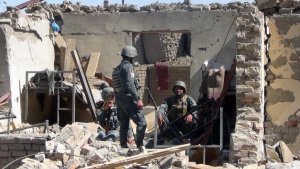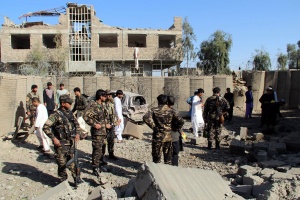
Taliban Innovation, Global Threat: Combined Suicide and Firearm Attacks

Taliban attacks in Afghanistan represent a decade-long evolution of terror tactics, drawing influence from a variety of operating groups and countries, including Afghan mujahedeen fighters, Al-Qaeda, and Iraqi insurgents. Suicide attacks in Afghanistan are a relatively recent development. Afghan mujahideen fighters did not use suicide tactics in their campaign against the Soviet Union in the 1980s, nor did the Taliban use them for the first four years of the War in Afghanistan. Only 30 suicide attacks were executed in Afghanistan between 2001 and 2005, a figure which can be explained by the ethnic makeup of the Taliban at that time. Both the Taliban and the mujahideen were largely ethnic Pashtuns who scorned suicide.
However, a fall 2005 meeting between Afghan Taliban and Iraqi insurgent leaders dramatically changed Afghanistan’s terror landscape. Iraqi insurgents introduced IED and suicide bomb technology to the Taliban, causing an immediate uptick in these types of attacks in Afghanistan. 139 suicide attacks were committed in 2006, and 160 in 2007. Further, a Taliban tactic used to devastating effect involves sending suicide bombers to breach security perimeters, followed by gunmen to carry out direct assaults on a target. The June 2008 attack on Sarpoza Prison near Kandahar City is an early example of this combined attack tactic. The prison breach was initiated with a detonation at the back wall of the prison, and an RPG-triggered truck bomb explosion at the front gate. Gunmen then stormed the prison, killing half of the 30 guards and freeing 1,000 Taliban prisoners. The efficacy of this tactic lies in its rapidity and its shock-value. Police stationed nearby were unable to repel hostile gunfire, and a Canadian quick-reaction force would not arrive until two hours after the violence ceased. Two months later, an attack on Camp Salerno in Khost leveraged the same tactic but was foiled when three bombers were shot and three others detonated before reaching their target. Around this time, the Taliban carried out similar attacks on foot patrols in Helmand province, detonating IEDs or suicide bombs and then launching ambushes with RPGs and small arms.
The implementation of combined attacks can be seen as a response to the failure of Taliban traditional suicide bombings. While Iraqi insurgent groups such as Ansar al-Sunnah and Al-Qaeda attack soft targets like markets, the Taliban focuses its attacks on military and police installations. For, it was these entities who were responsible for drastically reducing suicide bombing casualties before the introduction of combined attacks. In the first 22 bombings in 2007, only three caused fatalities. This trend continued into 2010, when the suicide bombing death toll was halved from where it stood in 2007 in part because of better training of security forces as well as NATO-led raids on bomb-making sites. Since late 2017, the Taliban has utilized Humvees and other military vehicles (often purchased by the US military for, and captured from Afghan security forces) as mobile IEDs. An October 2017 attack in Kandahar involving an opening car bomb, a firefight, and a second blast killed nearly three-quarters of an Afghan Army unit and allowed the Taliban to seize seven vehicles for use in future attacks. Rise to Peace’s Sara Huzar published an excellent analysis of this trend, which has the dual effect of being lethal and self-sustaining.
Combined attacks are now ubiquitous among terrorist groups around the globe. Rise to Peace’s Active Intelligence Database has identified more than 40 attacks since June 2017 that involve both suicide bombers and gunmen. The Taliban and Islamic State (ISIS and ISKP) are the most frequent practitioners of this method with 21 and 10 attacks respectively, but Al-Shabaab, Boko Haram, and others have also carried out combined attacks. Attacks combining the use of suicide bombs and firearms by these four groups caused a median of 27 total casualties, compared to 12 for attacks using only suicide bombs and 4 using only firearms. The mean casualties per attack was also highest for combined attacks at 40, compared to 23 for bomb-only attacks and 16 for firearm-only attacks. Each group’s reliance on combined attacks reflects the close relationship between suicide bombers in Iraq and Afghanistan. Both the Taliban and ISIS/ISKP carry out combined attacks at a much higher rate than the mean for the four groups examined, at 15 and 10 percent respectively compared to around 2 percent each for Al-Shabaab and Boko Haram.

The Rise to Peace dataset demonstrates that suicide attacks have higher casualty rates compared to non-suicide attacks. However, suicide attacks inherently involve the death of perpetrators and thus have a higher operational cost to terrorist groups. Combined attacks, therefore, represent a tactical option for terrorist groups seeking a high lethality-to-operational-cost ratio by increasing the lethality of non-suicide attacks while mitigating the operational cost of multiple suicide attacks. This helps the Taliban perpetrate effective attacks despite suboptimal target selection (assuming maximum casualties inflicted is a terrorist group’s optimal outcome). As mentioned previously, the Taliban primarily executes suicide attacks against “hard” targets such as the recent attack on Kabul’s Interior Ministry and the 2008 attack on Camp Salerno. However, analysis by Northeastern Political Science PhD and U.S. Navy Reserve officer Joseph Mroszczyk finds that the perpetrator-to-total death rate is virtually identical for suicide and non-suicide attacks against police or military targets. Since the Taliban is committed to these targets, combined attack tactics dramatically increase the group’s impact.
Taliban suicide attack tactics constitute a synthesis of experience, shared knowledge, and practical necessity. Since the introduction of suicide attacks in Afghanistan in 2005, the Taliban’s repertoire has evolved to include combined attacks because of target selection and the increased lethality of these methods. Rise to Peace’s data bears out this conclusion. It also highlights the spread of combined attack tactics to groups such as the Islamic State, Al-Shabaab, and Boko Haram who have all used them to deadly effect.
AID Methodology
Filter where [weapon] [has all of] [suicide bomb AND firearm], Group by [group] to find combined attacks by any group
Filter where [group] [has any of] [*insert group name here], Group by [weapon] to compare attack methodologies within each group (this can be used for bomb only and combined attacks]
Data involving firearms only ignores targeted attacks because of their unique nature (bomb only and combined attacks include targeted attacks since they impact bystanders as well)
To find this data: Filter where [group] [has any of] [*insert group name here] and [weapon] [has any of] [firearm] and [weapon] [has none of] [suicide bomb] and [tags] [has none of] [targeted]
ISIS data combines ISIS and ISKP
One attack involved both the Taliban and ISKP so totals will be slightly off because of single-counting this attack
